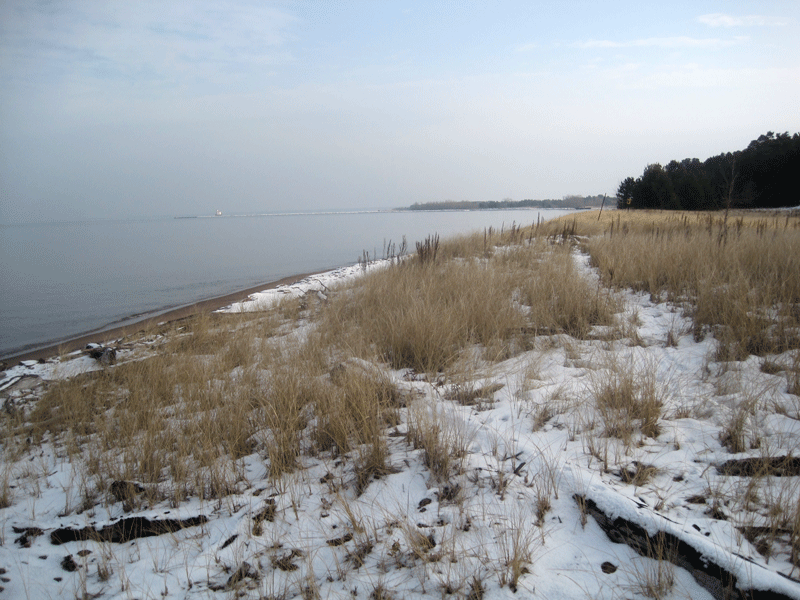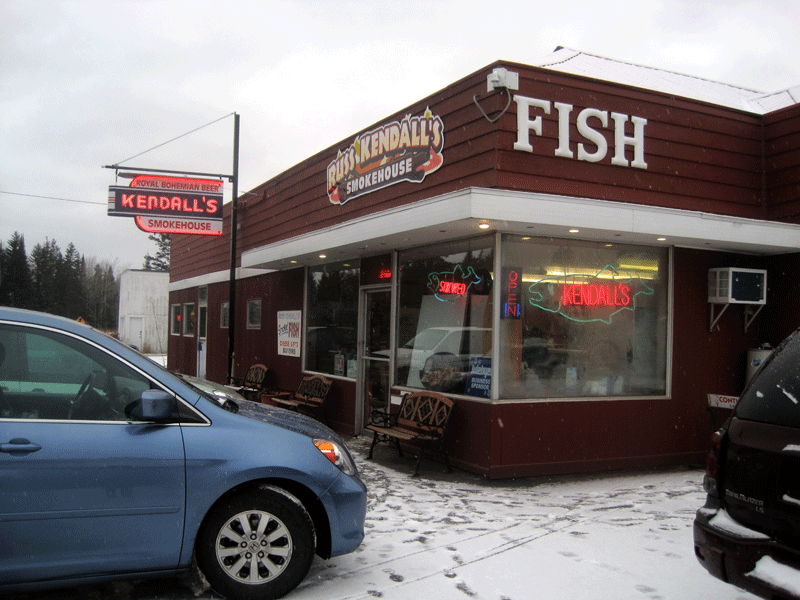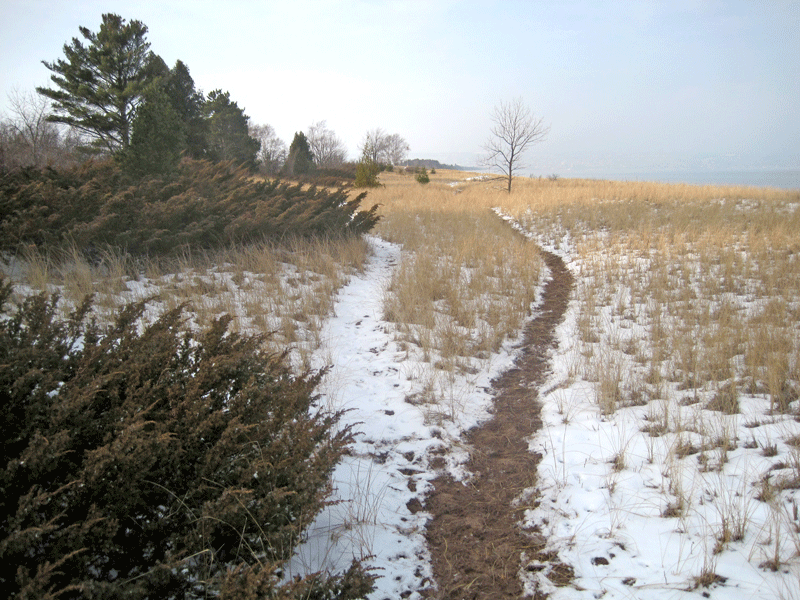During a conversation (and food) filled Thanksgiving afternoon with family and friends, several generations of women and men from three or four strands of the family discussed film production, the Ferguson protests, the history of St. Louis suburbs, Guardians of the Galaxy, breeding fish for fun and profit, Infinite Jest, the allure (or not) of Lake Michigan, kitchen remodeling, Augie's Bar in downtown Minneapolis, and the relative size of Thayer's and herring gulls.
Hilary and I returned home with enormous quantities
of leftover salmon mousse, one piece of mincemeat pie, two magnums of unopened
wine, and a modest foil packet of turkey and dressing.
It had all been warm and grand. But now our attention
turned to an adventure lying ahead. We'd arranged to spend the following night
in Two Harbors, a town three hours north of the Twin Cities that we often
breeze through on our way to the BWCA or to resorts further up the North Shore.
Along the way we intended to spend some time at one or two places in Duluth
that we typically bypass for the same reason—not enough time.
Our first stop was the trailhead to a stretch of the
Superior Hiking Trail that crosses Skyline Drive on its way inland toward Peace
Ridge, high above the city of Duluth. It was a pleasant walk through the
snow-dusted woods, with downy and hairy woodpeckers tapping here and there amid
the poplars, and the view was likely to improve the higher we went. But after
three-quarters of a mile we decided to turn around. It was already noon and we
had quite a few other stops in mind.
Continuing
east on Skyline Drive, we made a brief stop at Enger Park, but chose to skip
the climb up the tower, preferring to enjoy the expansive view from the
pavilion perched on the edge of the cliff.
After a truly mediocre lunch from Taco Johns,
consumed in a parking lot behind an insurance agency in a little neighborhood
called Beacon Point on the shores of the big lake that's been cut off from
downtown Duluth by the freeway, we continued east for twenty minutes along the scenic
route to Knife River.
We parked just west of the river, read a sign about the
ten million board feet of lumber that had been shipped out of the harbor or
down the railroad tracks from Knife River, then hiked through the woods upstream
to an enclosed metal fish ladder that lies just east of the expressway. The
smell of pines filled the air, and wood smoke wafted across the river from a
cabin on the other bank. Little pools of new-fallen snow rested on top of the
dead yarrow plants. Ah, winter!
We purchased a whole smoked herring at Russ
Kendell's Smokehouse for five dollars. They're building a new smokehouse behind
the shop to replace the one that burned down last spring. I noticed a few half-pint
containers of salmon spread selling for $6.50 a piece in one of the display
cases and suddenly realized that we had a gold mine in our refrigerator back
home!
In Two Harbors we bypassed our motel—light was
draining from the overcast sky, no time to check in—and parked at the head of
Burlington Bay on the east end of town. From there a city trail runs through a
grove of white pines planted to commemorate those who died in battle since WWI,
with side trails leading to rocky
outcrops along the shore.
Eventually the trail reemerges on a city street and then
heads down a hill past the water treatment plant to another foot trail leading
to even broader stretches of rocky shelves along the lake, cut off from the old
business district by a swath of trees. I'd never seen that stretch of coastline
before.
After traversing the rocks, we cut back through the
woods toward the harbor, passing just below the historic lighthouse. But a greater
sight lay just around the corner—an ore boat at the loading dock, strewn with
little white lights.
This remarkable sight reminded me only tangentially
of Christmas. What does Christ have to do with ore boats? But it did reinforce
the notion that twinkling lights in the darkness are more than attractive, they're
positively enchanting.
A small group of tourists was wandering back to
shore along the narrow breakwater in the shadowy light. To judge from their
accents I'd guess they were from somewhere in the Carolinas. Visiting family
over the holidays, no doubt.
Two common mergansers drifted aimlessly in the
harbor, their white breasts gleaming against the dark water; then they dove
into the murk below.
We wandered into the VFW (too smoky) and the Castle
Danger Brewpub (no food) before returning to our motel to check in, sit in the
hot tub, and take another look at the thin, stiff, coppery herring we'd bought
in Knife River. It was moist, fresh, good.
The next
morning we headed downtown again, where we read the signs about the two
impressive locomotives on display, paused in front of the house where a company
called Minnesota Mining and Manufacturing had been incorporated in 1902, and
watched a fox prance across the road and disappear into someone's back yard through
a wrought iron fence.
But we were out on the road early, heading east to
another section of the Superior Hiking Trail near Crow Creek. A faint wisp of
sleet was falling—enough to send me skidding past the turnoff to County Road 106.
A mile or so up the road, we found the parking lot. The
trail climbs steeply up a rocky bluff, delivering a payoff within fifteen minutes.
It offers a succession of views across the valley of Crow Creek toward the
distant lake and the long rocky ridge through which the Silver Creek Tunnel
passes.
Almost as remarkable as the view was the sight of a man running toward
us at breakneck speed down the rocky, snow-covered trail, carrying a water
bottle in one hand and listening to some electronic "music" that
consisted of little more than an urgent, metallic beat. As he went careering down
the snowy rock steps we'd just laboriously climbed up and disappeared into the
forest below, I was reminded of a herd of elk we came upon once in Yellowstone.
Also descending.
The key, I guess, is not to alight firmly anywhere,
but simply keep moving ahead.
For the most part, the guide we'd been using, Fifty Day Hikes on the North Shore by Andrew Slade, was more than useful—it was indispensable; but the "spur" the
author recommended to reach the highest ground and most spectacular views on
the Crow Creek Trail didn't look too promising to me.
Running along the edge of
a cliff and difficult to discern under an inch or two of snow, it looked less
like a trail than a one-way ticket to the emergency room.
So we returned to the car and continued east to
Gooseberry Park, where we hiked the Gitchi-gummi Trail on the east side of the
river. Along the way I spotted a muskrat on the foamy ice covering Second
Falls, searching (in vain) for a safe way to climb down to the river; and a little
vole bounding through the weeds, he resurfaced twice. At another point a ruffed grouse crossed the path just a few feet in front of us, then hid out in the crux of a bush until we lost interest.
The dead grasses all around were a rich golden brown
and the big lake was a steely green-gray. It wasn't that cold, we were both
well-dressed, but I didn't much feel like pondering the immensity of the
expanse. For some reason, things closer at hand were attracting my attention.
A single fox had been bounding along the trail in
front of us for most of the way. We didn't see it, but we saw the tracks. Otherwise,
the only signs we saw, aside from weasel and mouse tracks in the snow, were those
of a large rabbit, bunched close together but spaced about five feet apart. It
seems he was on the run from something. (But maybe he just felt like running.)
Back in Duluth, we took our final hike of the
day—out through a small pine barren beyond the airport at the end of Park Point.
The pines themselves date back to 1798 at least, according to the sign.
The sun had finally come out and the sky was a soft
blue covered with long stripes of diaphanous pillow-like clouds. The tan beaches were rimmed
with miniature drifts of snow, there were broad planes of ice under the snow cover
where the waves had lapped up across the sand and then frozen. (I wouldn't have
known that, but you could see the tracks of those who had ventured out toward
the lake, slipped, and fallen.) The grasses on the dunes looked healthy. Off in
the distance to the east I could see the lighthouse on the pier at Wisconsin
Point, on the other side of the sandbar, very close but separated from us by
ninety minutes of drive-time.
We passed a bunch of people for the first time along
the sandy trail through the woods—well, we were practically in downtown Duluth.
It was a family group, they'd been attempting to cross-country ski, though the dearth
of snow made it impossible. We came upon their skis, leaned up against a tree,
before we saw them wandering in our direction down the sandy path in the shadow
of the woods.
Four or five seaplanes were parked in a snow-covered
lot beyond the cyclone fence protecting the airport. Eventually we crossed a
stretch of private property that housed the high voltage fixtures for the
airport lights, and I saw an evening grosbeak sitting on the metal fence
enclosing the electrical boxes. That was a treat.
Evening
grosbeaks usually travel in flocks, I said to myself. But
as the bird flew off he was joined in flight by another, similar-looking bird,
and I was reassured.
That was the last thing of interest that happened on
our little 24-hour North Shore trip. Unless you count the fishermen heading out
to their ice houses in the harbor, with the ocean-going ships and grain
elevators beyond them in the distance.
But it occurs to me now that we didn't actually finish most of the hikes we started. We
didn't really take the spur, or get to the opening between Minnesota and
Wisconsin Points, or climb Enger Tower, or reach the open country up on Peace
Ridge.
To which I say, So what? We did more than we had
done. And next time we'll do more still. And we'll stop in at the brew pub, and
the walleye cakes at the Rustic Inn will be better, and the fox will appear.
And so on, all down the line.












No comments:
Post a Comment